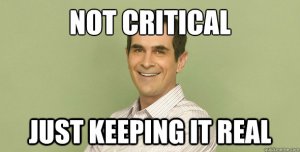When it comes to filming sitcoms, there is no greater debate among producers as to which visual approach is key to comedic gold: single-cam or multi-cam?
Essentially, there is a methodology towards filming sitcoms. Single camera sitcoms are filmed (as the name indicates) using only one central camera. This allows directors to shoot outside of studio sets, utilizing their locations, and maximizing a realistic approach towards filming scenes. This has been the most popular form of filming for the past 10 years, due to a much more responsive young adult audience base. Single camera sitcoms are also famous for NOT using laugh tracks. Think shows like “The Office,” “30 Rock,” “Modern Family,” “Parks and Recreation,” and “The Mindy Project.” The idea of single-cam sitcoms is generally summed up like this: single-cam = critically beloved, but barely watched.
Multiple camera sitcoms, reversely, are filmed with the use of many cameras (usually 3-4). This method prohibits off-set shooting, thus creating the quintessential stigma of “old-school” sitcoms. They are shot in one large studio set, the camera flipping from character to character, in front of a live studio audience. This aids in creating mass followers who grow to love familiar sets. Multiple camera sitcoms are also the birthplace of the infamous laugh track. Think shows like “The Big Bang Theory,” “Saturday Night Live,” “Seinfeld,” “Friends,” and “How I Met Your Mother.” The idea of multi-cam sitcoms is generally summed up like this: multi-cam = critically dismissed, but widely watched.
John Mulaney is the latest undertaker in striving to make the out-of-date, normcore of multi-cam taping, into something revived and repurposed like single-cam filming. Is how a sitcom is filmed, truly the indicator of its success? Let’s dig a little deeper…

Mulaney, multi-cam, being shot with a live studio audience (ray rickshaw/FOX)
In his self-titled new show on FOX, John Mulaney is mirroring a platform set by an old-school classic; “Seinfeld,” through its use of live studio audiences and multi-cam taping. Popularity of this approach has massively dwindled from the early 90’s due to the appeal of single-cam realism on most channels EXCEPT for one big anomaly; CBS. The network has been the leader in cranking out explosive mass hits, filmed the old-fashioned way, such as “The Big Bang Theory” and “Two and a Half Men.” Creators of new sitcoms are feeding off of successful predecessors and dipping their toes in single studio sets and laugh track induced sketches, hoping to recreate the glory of sitcoms past. So how come most multi-cam sitcoms are loved by the masses but critically shredded? While some of the most beloved sitcoms were brought to us through multi-cam studios, queuing a laugh track won’t make a dry joke any funnier. The basis of a sitcom, bottom line, is comedy. There is a vapidness that comes with modern sitcoms, an animosity in not establishing a purpose for the show or its characters. A common misconception of multi-cam shooting is that they are not “specific enough.” While plot lines aren’t required to tell a definite story or achieve a deliberate outcome like in film, the point of multi-cam shooting is to make a sitcom feel accessible to viewers invested in all levels of commitment while staying authentic to the characters. It’s all about the essences cultivated here. The need to bring back the glorification associated with sitcoms past won’t be attained by adding more cameras, but by writing and delivering with more depth.
What’s the deal with single cam sitcoms then? If they are garnering more modern generational viewership, and adopting the better liked “movie style” method of filming, why is everyone so desperate to move backwards and film sitcoms using multi-cams again? And why is it that despite being critically worshipped, their audience is very select and few? Single-cam sitcoms are true to their craft. By utilizing the ability to shoot in multiple locations, the story lines are generally more interesting to watch. The abandoning of the infamous laugh track provides well-written comedic material to shine through instead of being masked by forced reactions. Single-cam shows like “Modern Family” and “The Office” are breakthroughs for the quality of their development and the mastery of their characterization. Why is there a need to go back to old methods when smart, quippy casts and quotes are right under our noses? Perhaps it’s the hype and endorsements of multi-cam shows by their deep-pocketed networks which distract audiences from from focusing on the quality of the content. Sitcoms have only one purpose, to make their audience laugh. Why should we give a show our undivided attention and eternal devotion if it doesn’t do the same in regards to building a community? An audience cannot connect to a character that has yet to connect with their self. John Mulaney is a talented stand-up comedian, but falls flat of playing himself as a role. As the star of the show, he needs to cultivate an aesthetic, that is signatory to himself and who he wishes his character to be. Perhaps the best way for this to be achieved is through single-cam filming.
You can try to laugh your way out of a mistake, but you can’t fake funny.

How soon is the curtain call for Mulaney? (creative commons for fox network)






